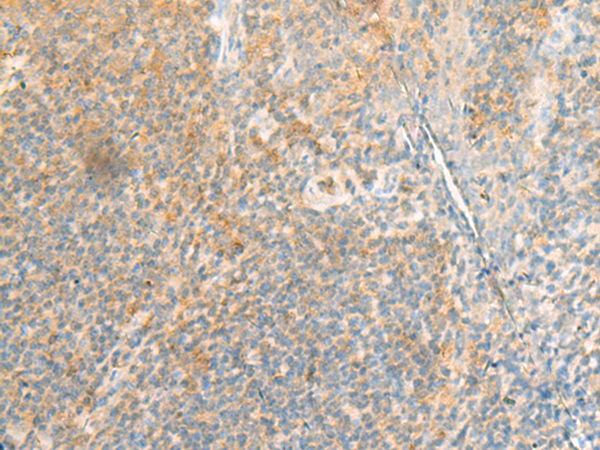
| WB | 咨询技术 | Human,Mouse,Rat |
| IF | 咨询技术 | Human,Mouse,Rat |
| IHC | 1/20-1/100 | Human,Mouse,Rat |
| ICC | 技术咨询 | Human,Mouse,Rat |
| FCM | 咨询技术 | Human,Mouse,Rat |
| Elisa | 1/5000-1/10000 | Human,Mouse,Rat |
| Aliases | p18; PDRO; C11orf59; p27RF-Rho; Ragulator1 |
| Host/Isotype | Rabbit IgG |
| Antibody Type | Primary antibody |
| Storage | Store at 4°C short term. Aliquot and store at -20°C long term. Avoid freeze/thaw cycles. |
| Species Reactivity | Human, Mouse, Rat |
| Immunogen | Synthetic peptide of human LAMTOR1 |
| Formulation | Purified antibody in PBS with 0.05% sodium azide and 50% glycerol. |
+ +
以下是关于LAMTOR1抗体的3篇代表性文献的简要信息:
1. **文献名称**: "The lysosomal signaling anchor p18 (LAMTOR1) is essential for mTORC1 activation"
**作者**: Sancak Y. et al.
**摘要**: 该研究揭示了LAMTOR1作为mTORC1复合体的关键锚定蛋白,在溶酶体表面介导氨基酸依赖性mTORC1激活中的作用,强调了其在细胞代谢调控中的核心地位。
2. **文献名称**: "Regulation of mTORC1 by the Rag GTPases is necessary for neonatal autophagy and survival"
**作者**: Efeyan A. et al.
**摘要**: 通过基因敲除模型,研究发现LAMTOR1缺失导致小鼠胚胎致死,并破坏Rag GTPase介导的mTORC1定位,证明其在自噬和发育中不可或缺。
3. **文献名称**: "Spatial control of mTORC1 by lysosome-anchored protein complex LAMTOR/Ragulator"
**作者**: Bar-Peled L. et al.
**摘要**: 该文献阐明了LAMTOR1作为Ragulator复合体的核心组分,通过锚定mTORC1至溶酶体膜,调控其对营养信号的响应,为靶向mTOR通路的疾病治疗提供理论依据。
这些研究均使用LAMTOR1抗体进行蛋白定位、复合体互作或功能验证实验,是理解其在细胞信号转导中作用的经典参考文献。
LAMTOR1 (Late Endosomal/Lysosomal Adaptor, MAPK and mTOR Activator 1), also known as p18 or Ragulator1. is a critical component of the Ragulator complex that anchors the mTORC1 signaling pathway to lysosomal membranes. This protein plays a pivotal role in nutrient sensing, cellular metabolism, and autophagy by regulating mTORC1 activation in response to amino acid availability. Structurally, LAMTOR1 contains a lipid-binding domain that facilitates its association with lysosomal membranes and serves as a scaffold for assembling other Ragulator subunits (LAMTOR2-5).
Antibodies targeting LAMTOR1 are essential tools for studying its function and interactions in mTOR signaling. They are widely used in techniques such as Western blotting, immunofluorescence, and immunoprecipitation to detect protein expression, subcellular localization, and complex formation. High-quality LAMTOR1 antibodies exhibit specificity for distinct epitopes, often validated through knockout or knockdown controls, ensuring reliability in experimental models.
Research applications span cancer biology, neurodegenerative diseases, and metabolic disorders, as dysregulation of LAMTOR1 is linked to aberrant mTOR signaling in these conditions. Additionally, these antibodies aid in exploring therapeutic targets by elucidating how LAMTOR1-mediated lysosomal positioning and nutrient sensing influence cell growth and survival. Host species (e.g., rabbit, mouse) and clonality (monoclonal/polyclonal) are selected based on experimental requirements, balancing sensitivity and specificity. Proper validation under specific experimental conditions remains crucial for reproducible results.
×